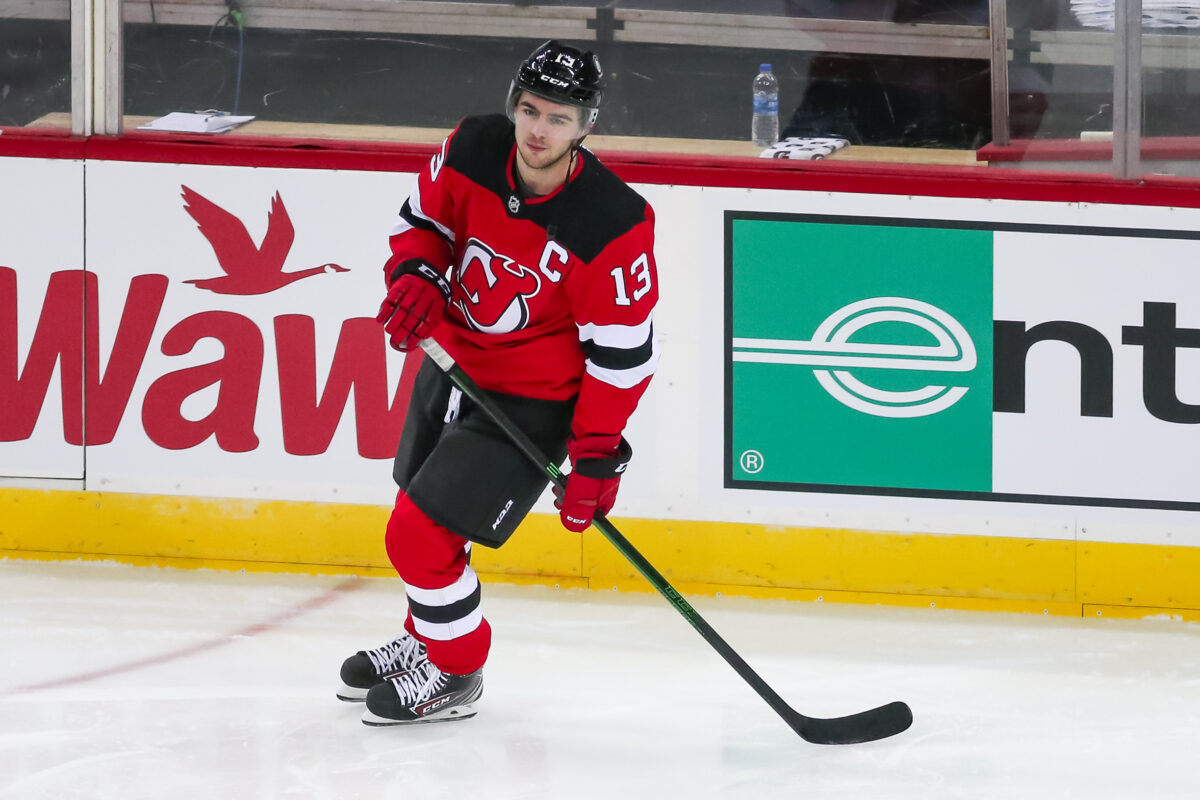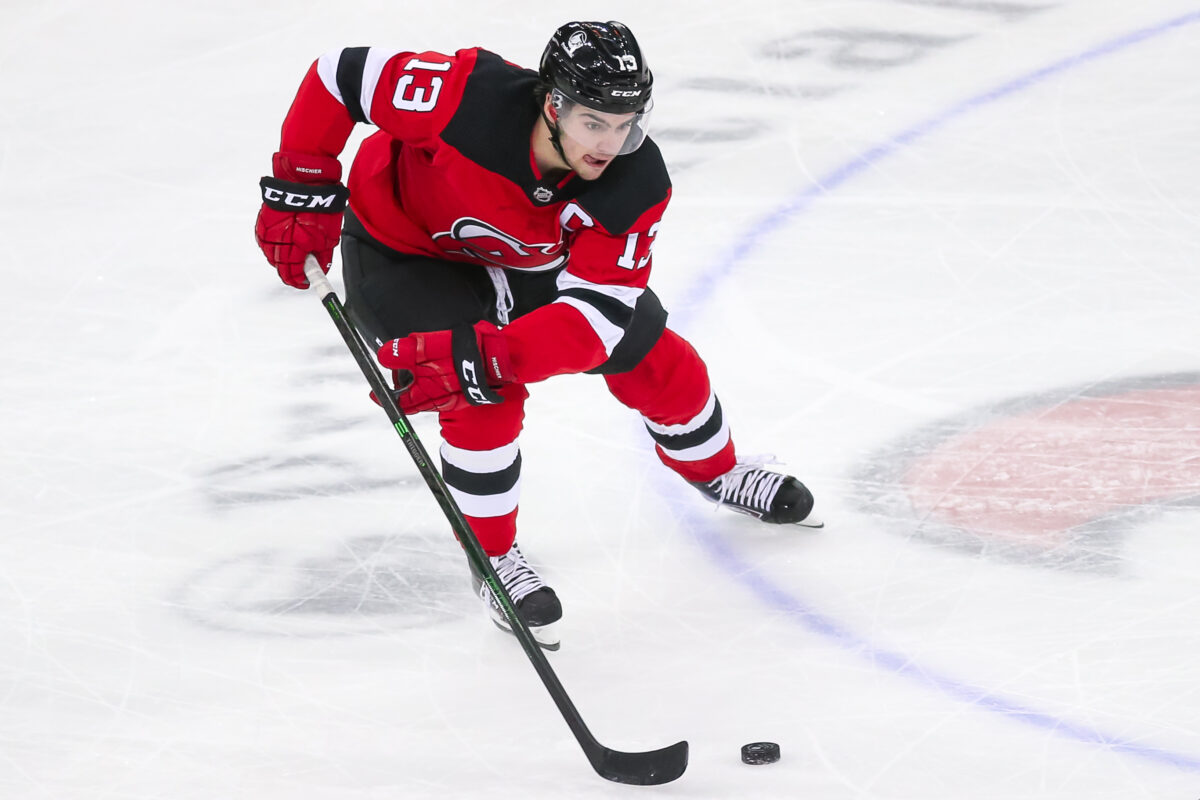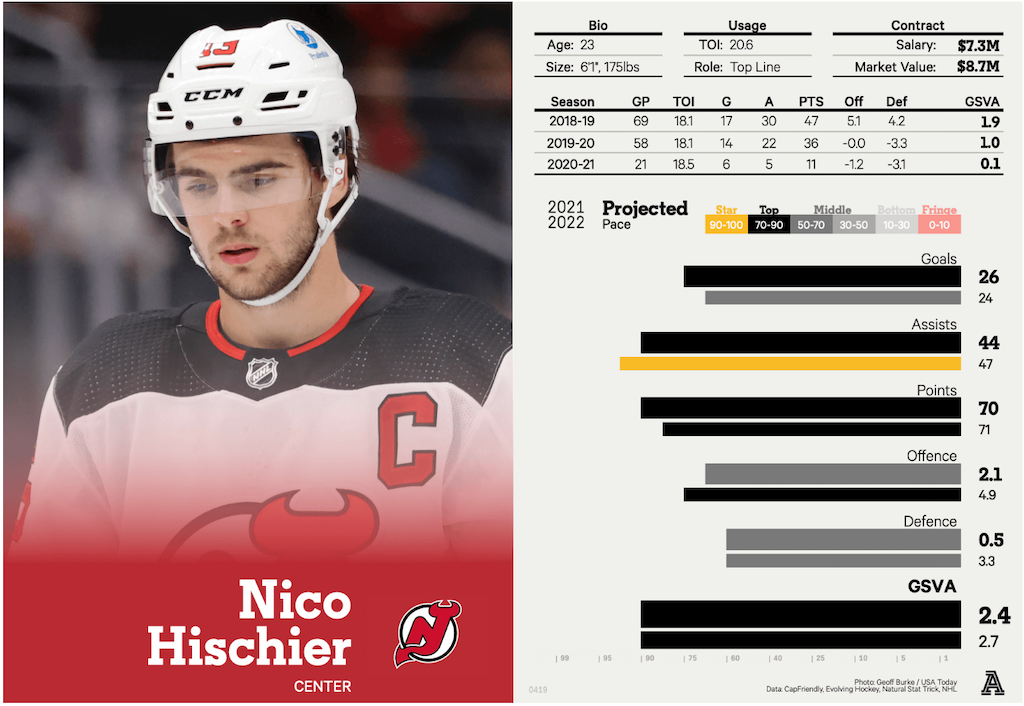Another season and another trip to the bottom of the NHL standings for the New Jersey Devils. Many of the same problems (goaltending, the power play) were part of that downfall. But unlike in years past, there was some good to come out of the 2021-22 campaign. Jack Hughes only played in 49 games due to injuries, but he finished with 56 points — a 94-point pace over 82 games.
Hughes was a prime candidate for a breakout year before the 2021-22 season began, but he wasn’t the only Devil who emerged as a top-line center. Fellow former first overall pick Nico Hischier also found his footing and emerged as a true top-six, borderline first-line center for the Devils.
Heading into tonight’s game against the Ottawa Senators, Hischier has 59 points in 69 games — a 70-point pace over 82 games. The production has been there, but it’s not just about the scoring. Hischier has finally made the kind of impact you’d expect from a first overall pick, and that’s good news for the Devils heading into what should be a busy offseason.
Hischier’s Offense Popped After All-Star Break
The 2021-22 season was a tale of two seasons for Hischier: the 39 games before the All-Star break and the 30 games after the All-Star break. His production in that first 39-game stretch was far from terrible. Eight goals and 24 points comes out to a 16-goal and 50-point pace over 82 games. But for a player who was the first overall pick in 2017, you’d expect more of someone who former general manager Ray Shero signed to an extension worth $7.25 million a year.
At the same time, Hischier was not playing poorly. He had a Corsi for percentage (CF%) of 53.6 percent and an expected goals percentage (xG%) of 53.09 percent at five-on-five through his first 30 games. He was averaging 1.95 points per 60 minutes, so he was scoring at the level you’d expect from a top-six center.

The reason for the lack of production from Hischier was some poor shooting luck, specifically when he was on the ice. The Devils only converted on 6.41 percent of their five-on-five shots when Hischier was on the ice, the sixth-lowest on the team (min. 100 minutes played). He may have been doing his part, but his teammates weren’t converting on many of the chances he created when he was on the ice.
But once the team returned from the All-Star break, that on-ice shooting percentage flipped in a big way. Since then, the Devils have had a shooting percentage of 12.54 percent with him on the ice. The only Devils skaters with higher on-ice shooting percentages are Hughes and Yegor Sharangovich. That percentage may seem high, but when you’re as good at creating chances as Hischier, eventually your teammates will capitalize on those chances. And he’s quite good at it:
Per JFresh’s graphic, Hischier ranks in the 94th percentile or higher in zone entries among his peers. And most importantly, he ranks in the 98th percentile in creating a chance off an entry. That’s what’d you expect of a center who’s a high-end play-driver. While he doesn’t shoot much off the rush (Hischier has a good shot, so he might want to do that more often), he generates assists off the rush at a high rate (96th percentile).
That’s led to much more scoring for Hischier since the All-Star break, as he has 35 points (13 goals, 22 assists) in 30 games. He hasn’t suddenly turned into a 90-plus-point center, but when looking at the whole product, a 25-goal, 70-point player seems like an achievable target more often than not moving forward. And fortunately, it’s not just his offense that’s improved too.
Hischier’s Two-Way Reputation Now Legit
During the first few seasons of Hischier’s career, he garnered a reputation as a top-flight defensive center, at least from Devils fans. That wasn’t necessarily unwarranted or completely untrue. With the exception of his rookie season, he wasn’t a poor defensive player, but he wasn’t the elite two-way center that he was maybe thought to be.
Related: 2012 Redraft: What if the Edmonton Oilers Didn’t Take Nail Yakupov?
From the start of the 2018-19 campaign to the end of last season, Hischier’s even-strength defense was worth an expected goals above replacement (xGAR) of minus-1.7. Not terrible, but not great. With that said, it’s worth noting his 2020-21 was essentially a wash because he only played in 21 games due to injuries. His even-strength defense was worth an xGAR of minus-1.1 that season, which is where the minus-1.7 comes from for the most part.
But even though Hischier’s defensive impact wasn’t great, you could see the potential for that to change down the road. He’s a strong back checker and gets in shooting lanes to block shots. He plays hard defensively, so it’s not likely he couldn’t have a more significant impact in his own zone. This season, those things have started to come together. His even-strength defense has been worth an xGAR of 1.7, second on the team among forwards to Pavel Zacha, who happened to be one of Hischier’s most common linemates in 2021-22.

Another significant reason for Hischier’s improved defensive game is he’s become a much better shot suppressor. In his three prior seasons, he averaged nearly 59 shot attempts and 2.47 expected goals against per 60 minutes at five-on-five. This season, those are down to 54.97 shot attempts and 2.35 expected goals against per 60. Not only is he suppressing quantity at a better rate, but he’s also allowing less quality. That’s all the more impressive, considering the Devils play a run-and-gun, high-event system under coach Lindy Ruff, meaning there’ll be some shots and chances allowed defensively.
While 2021-22 was Hischier’s fifth season in the league, it’s easy to forget he just turned 23 years old in January. A player’s defensive game doesn’t always come around right away, and it sometimes takes a few years for it to develop to be truly impactful in the NHL. That seems to be the case for Hischier, and considering his best years of hockey are still ahead of him, his defensive game should continue to be solid and even improve from here on out.
What’s Next for Hischier
With Hughes’ breakout season and him only going to get better (he doesn’t turn 21 for another month), the Devils have a formidable 1-2 punch down the middle taking shape between him and Hischier. If this is the type of player the Devils are getting in Hischier moving forward, they’re going to be able to score plenty of goals with him, Hughes, Jesper Bratt and Sharangovich in the top-six:

Per Dom Luszczyszyn’s model at The Athletic, a longer pace bar than the projected bar means his model expects a player to come down to Earth a bit based on their history (from ‘Introducing our NHL Player Cards: Quick, digestible data on players from all 32 NHL teams,’ The Athletic – 3/7/2022). But with Hischier, both bars are about equal in every category, so it doesn’t expect him to regress much at all. He has all the tools to be a consistent 20-plus-goal, 40-plus-assist center. And with him now being the clear second-line pivot behind Hughes, that production may come more easily for him since opposing teams will likely be focusing on how to shut down Hughes’ line.
As is the case with Hughes, Hischier could also use more scoring help on his wings. Bratt has always played very well with Hischier, so I’d expect him to be one of his most common linemates in 2022-23. The question is, where will the help come from? Will it be an internal solution like Dawson Mercer or Alexander Holtz? Or will general manager Tom Fitzgerald seek outside help? Either scenario seems just as likely and is something that will play out over the coming weeks ahead of the draft and free agency in the first part of July.
But either way, it seems that Hischier is here. He just had the best year of his career during his age-23 season, so there should be plenty of more good hockey ahead for him. With Hughes inching closer to superstar status, there’s a clear core to build around with him and Hischier. Now it’s about surrounding them with more talent this summer.
* * *
Advanced stats from Natural Stat Trick, Evolving-Hockey
